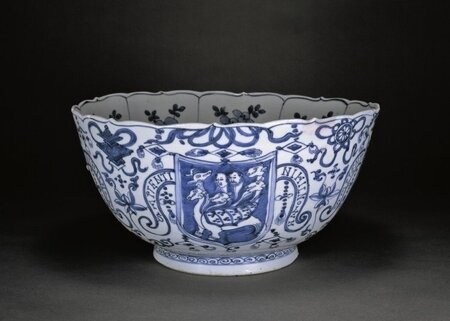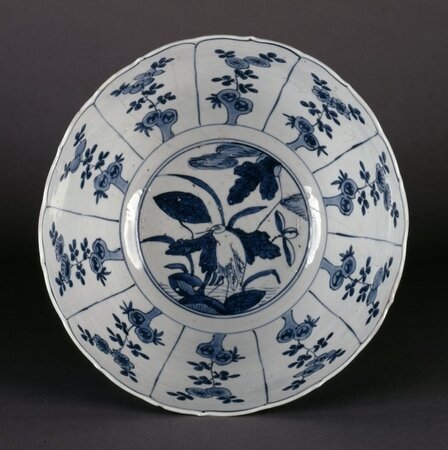Large porcelain bowl with 'kraak'-type underglaze blue decoration. , 1600-1620. Wanli period, Ming dynasty
Large porcelain bowl with 'kraak'-type underglaze blue decoration. , 1600-1620. Wanli period, Ming dynasty. Registration number: 1957,1216.19. © The Trustees of the British Museum
This bowl has rounded sides and a bracket-lobed rim and stands on a spreading foot ring. It is painted in bright underglaze blue with four armorial-style shields each containing a hydra with two human heads and five heads of fabulous beasts with scaled wings, a tail and two legs with hooves. The shields have streamers attached on either side inscribed with the Latin maxim or proverb, 'Septenti nihil novum' (sic) [To the wise man nothing is new]. The remaining decorative motifs are Chinese. On the outside are Buddhist emblems and lotus flowers and on the inside are ten panels with highly stylized flowering and fruiting plants growing by rocks, arranged around a crane in a lotus pond. Height: 17.3 centimetres. Diameter: 34.6 centimetres. Weight: 2.3 kilograms
Harrison-Hall & Krahl 1994:
The shape of these shields and the presence of a motto suggest a Western armorial origin of this design but its source has not yet been traced. The motif has been compared (Gray, 1960) to a similar seven-headed hydra in a printed illustration in Camillo Camilli's "Impresse Illustri" (Venice, 1586). Although this hydra is similarly depicted, it is neither contained within a shield nor is the motto found there. The same shield design and motto appear again on the inside of a dish in the Santos Palace, Lisbon, Portugal, where it forms part of a pyramid-shaped ceiling festooned with Ming porcelain. Among those pieces which were collected by Don Manuel I, King of Portugal (r. 1495 - 1521) and his successors, it is the only piece of Chinese porcelain with a European motif and inscription (Lion-Goldschmidt, 1984 - 85, pl. 18). This would suggest that these pieces were made for the Portuguese market. An identical bowl, however, is depicted in a somewhat later Dutch oil-painting, a still-life by W.C Heda, dated 1638 (Spriggs, 1964 - 66, pl. 68a) which proves that such pieces also came to Holland. Although such porcelains with Western motifs and inscriptions were obviously made for Western customers, the present bowl is particularly interesting, as its type can not only be traced to 17th-century Portugal and 17th-century Holland, but also to 17th-century Persia. An earthenware bowl closely imitating this piece, made in Persia in the second half of the 17th century, is in the Victoria and Albert Museum, London. It has an imitation Chinese seal mark on the base which the original lacks.
The appearance of this specific design in three different countries with an interest in Chinese porcelains, suggests that in the 17th century the export trade was still fairly unstructured. This bowl belongs to a general type of late Ming blue-and-white export porcelain known in the West as 'kraak' ware, which is characterized by a fairly thin body and panelled decoration. Produced at Jingdezhen and exported in bulk, it derives its name from the Portuguese ships called 'carraca' (English 'carrack' and Dutch 'kraak') which brought the first such pieces to Europe.
The Willem Claesz Heda (1594-c.1681) painting is in the Hamburger Kunsthalle.JHH 2009

/https%3A%2F%2Fprofilepics.canalblog.com%2Fprofilepics%2F1%2F0%2F100183.jpg)
/https%3A%2F%2Fstorage.canalblog.com%2F03%2F02%2F119589%2F96711876_o.jpg)
/https%3A%2F%2Fstorage.canalblog.com%2F11%2F31%2F119589%2F94773502_o.jpg)
/https%3A%2F%2Fstorage.canalblog.com%2F20%2F83%2F119589%2F94772815_o.jpg)
/https%3A%2F%2Fstorage.canalblog.com%2F26%2F72%2F119589%2F75604929_o.jpg)
/https%3A%2F%2Fstorage.canalblog.com%2F59%2F60%2F119589%2F26458628_o.jpg)




/http%3A%2F%2Fstorage.canalblog.com%2F37%2F05%2F119589%2F120373916_o.jpg)
/http%3A%2F%2Fstorage.canalblog.com%2F60%2F10%2F119589%2F113139827_o.jpg)
/http%3A%2F%2Fstorage.canalblog.com%2F48%2F83%2F119589%2F96649014_o.jpg)
/http%3A%2F%2Fstorage.canalblog.com%2F74%2F46%2F119589%2F95895471.jpg)